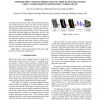Free Online Productivity Tools
i2Speak
i2Symbol
i2OCR
iTex2Img
iWeb2Print
iWeb2Shot
i2Type
iPdf2Split
iPdf2Merge
i2Bopomofo
i2Arabic
i2Style
i2Image
i2PDF
iLatex2Rtf
Sci2ools
ICIP
2010
IEEE
2010
IEEE
Stereoscopic content production of complex dynamic scenes using a wide-baseline monoscopic camera set-up
Conventional stereoscopic video content production requires use of dedicated stereo camera rigs which is both costly and lacking video editing flexibility. In this paper, we propose a novel approach which only requires a small number of standard cameras sparsely located around a scene to automatically convert the monocular inputs into stereoscopic streams. The approach combines a probabilistic spatio-temporal segmentation framework with a state-of-the-art multi-view graph-cut reconstruction algorithm, thus providing full control of the stereoscopic settings at render time. Results with studio sequences of complex human motion demonstrate the suitability of the method for high quality stereoscopic content generation with minimum user interaction.
ICIP 2010 | Image Processing | Stereoscopic | Stereoscopic Content Generation | Stereoscopic Video Content |
| Added | 12 Feb 2011 |
| Updated | 12 Feb 2011 |
| Type | Journal |
| Year | 2010 |
| Where | ICIP |
| Authors | Jean-Yves Guillemaut, Muhammad Sarim, Adrian Hilton |
Comments (0)

